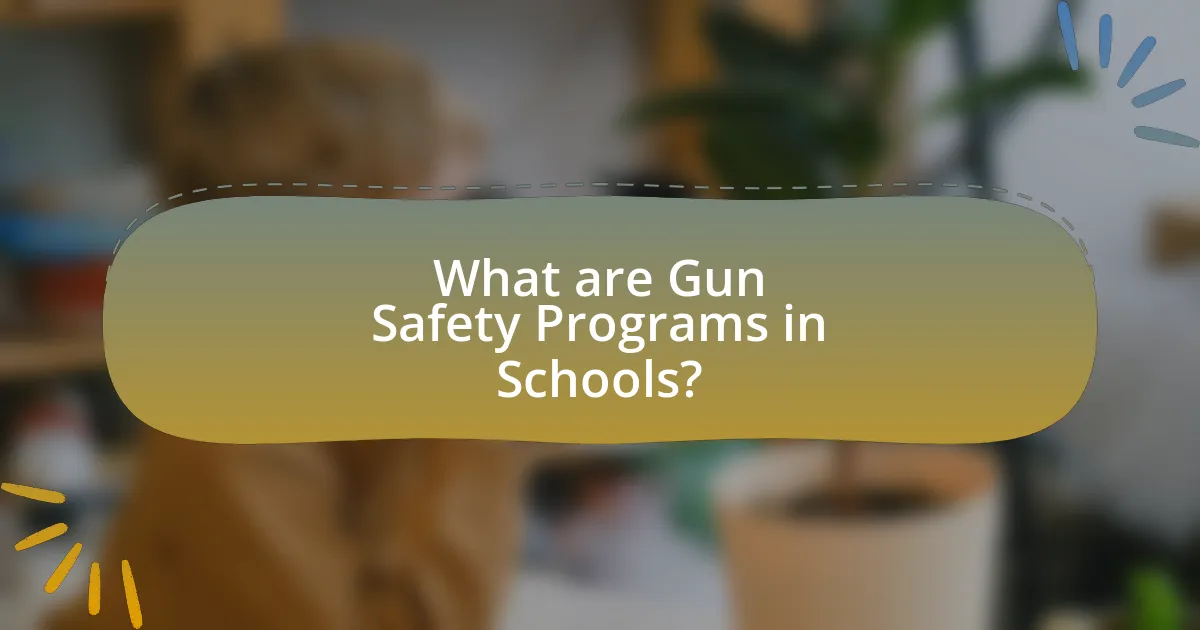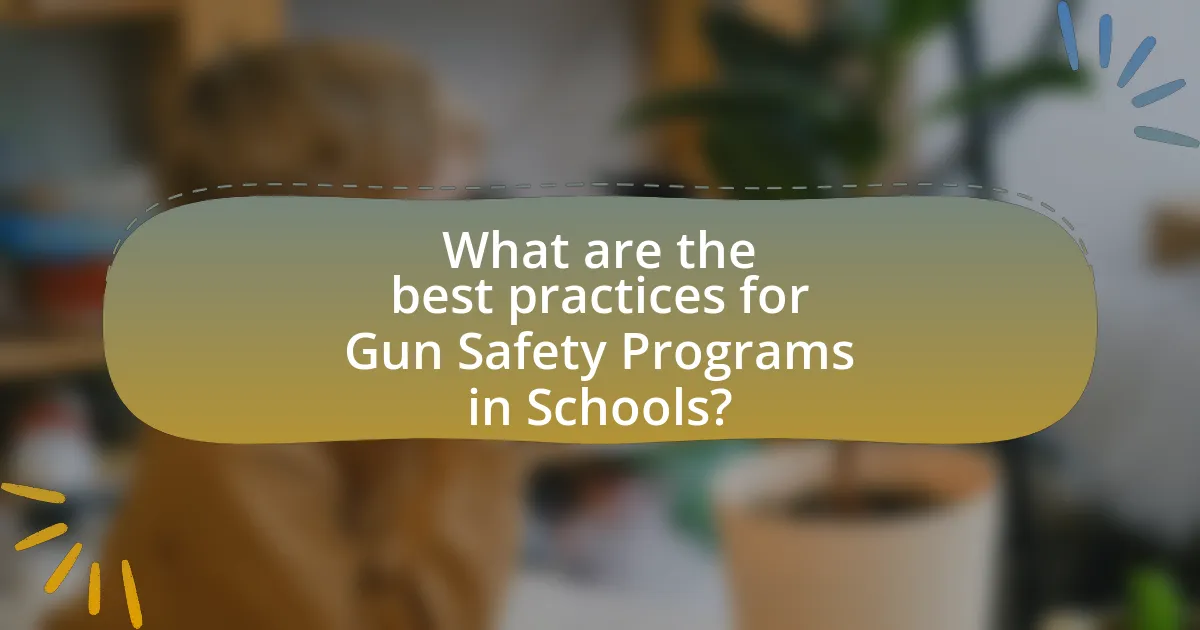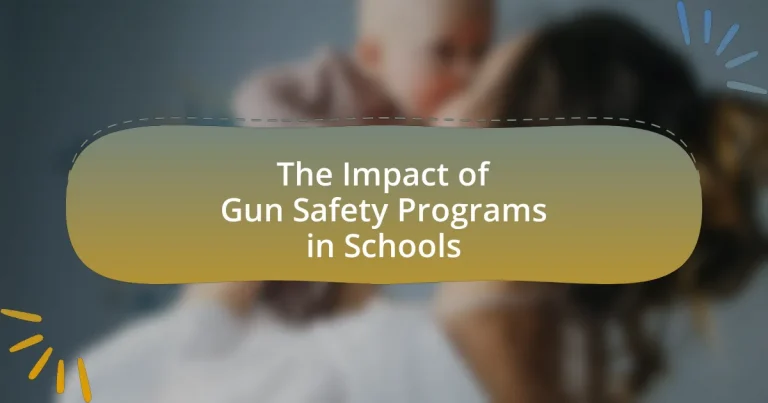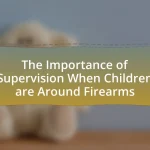Gun safety programs in schools are educational initiatives aimed at teaching students the safe handling, storage, and use of firearms to reduce the risk of gun-related accidents and violence. These programs incorporate structured curricula, interactive lessons, and community involvement, demonstrating effectiveness in decreasing unintentional shootings and promoting responsible behavior among youth. Research indicates that comprehensive gun safety education can lead to significant improvements in students’ knowledge and attitudes towards firearm safety, ultimately contributing to a safer school environment. The article explores the operation, key components, challenges, and best practices of gun safety programs, as well as the evidence supporting their effectiveness in enhancing student awareness and reducing firearm-related incidents.

What are Gun Safety Programs in Schools?
Gun safety programs in schools are educational initiatives designed to teach students about the safe handling, storage, and use of firearms. These programs aim to reduce the risk of gun-related accidents and violence among youth by providing age-appropriate information and skills. Research indicates that comprehensive gun safety education can lead to a significant decrease in unintentional shootings and promote responsible behavior regarding firearms. For instance, a study published in the Journal of School Health found that students who participated in gun safety programs demonstrated improved knowledge and attitudes towards gun safety, highlighting the effectiveness of such initiatives in fostering a safer school environment.
How do Gun Safety Programs operate within educational settings?
Gun safety programs operate within educational settings by providing structured curricula that educate students about firearm safety, responsible behavior, and the legal implications of gun ownership. These programs typically include interactive lessons, discussions, and practical demonstrations aimed at fostering a culture of safety and awareness among students. Research indicates that schools implementing such programs have reported a decrease in accidental shootings and an increase in students’ understanding of gun safety principles, as evidenced by a study published in the Journal of School Health, which found that students exposed to gun safety education showed a 30% improvement in safety knowledge compared to those who did not participate.
What are the key components of effective Gun Safety Programs?
Effective Gun Safety Programs consist of education, training, and community involvement. Education provides individuals with knowledge about firearm safety, including safe handling, storage, and the legal responsibilities associated with gun ownership. Training involves practical exercises that teach safe practices and emergency response, ensuring participants can apply their knowledge in real-life situations. Community involvement fosters a supportive environment where families, schools, and local organizations collaborate to promote safety and awareness. Research indicates that comprehensive programs that integrate these components significantly reduce accidental shootings and promote responsible gun ownership, as evidenced by studies showing a 43% decrease in firearm-related accidents in communities with active gun safety initiatives.
How are these programs implemented in schools?
Gun safety programs are implemented in schools through structured curricula that include educational workshops, interactive training sessions, and community partnerships. These programs often involve collaboration with local law enforcement and health organizations to provide comprehensive training on firearm safety, conflict resolution, and emergency response. For instance, the National Association of School Psychologists emphasizes the importance of integrating gun safety education into existing health and safety curricula, ensuring that students receive age-appropriate information. Additionally, schools may conduct drills and simulations to reinforce the training, thereby enhancing students’ preparedness in real-life situations.
Why are Gun Safety Programs important for students?
Gun safety programs are important for students because they educate young individuals about the risks associated with firearms and promote responsible behavior. These programs provide critical knowledge on how to handle firearms safely, recognize dangerous situations, and understand the legal implications of gun ownership. Research indicates that educational interventions can significantly reduce accidental shootings and gun-related incidents among youth. For instance, a study published in the Journal of Adolescent Health found that students who participated in gun safety education were 50% less likely to engage in risky behaviors involving firearms. This evidence underscores the necessity of implementing gun safety programs in schools to foster a safer environment for students.
What risks do Gun Safety Programs aim to mitigate?
Gun Safety Programs aim to mitigate the risks of accidental shootings, firearm-related injuries, and suicides among youth. These programs educate students about safe handling, storage, and the importance of reporting unsafe situations, which can significantly reduce the likelihood of tragic incidents. For instance, research indicates that states with comprehensive gun safety education have seen a decrease in unintentional firearm deaths among children.
How do these programs contribute to a safer school environment?
Gun safety programs contribute to a safer school environment by educating students about the risks associated with firearms and promoting responsible behavior. These programs often include training on how to recognize and report unsafe situations, which can lead to a reduction in incidents involving guns in schools. For instance, research from the National Institute of Justice indicates that schools implementing comprehensive gun safety education see a significant decrease in firearm-related incidents, highlighting the effectiveness of such programs in fostering a culture of safety and awareness among students.

What evidence exists regarding the effectiveness of Gun Safety Programs?
Gun safety programs have demonstrated effectiveness in reducing firearm-related incidents among children and adolescents. Research indicates that programs incorporating education on safe handling, storage, and the risks associated with firearms lead to increased awareness and responsible behaviors. For instance, a study published in the journal “Pediatrics” by researchers at the University of Michigan found that children who participated in gun safety education were significantly less likely to engage in risky behaviors, such as handling firearms unsupervised. Additionally, a meta-analysis conducted by the American Academy of Pediatrics reviewed multiple studies and concluded that comprehensive gun safety programs can decrease the incidence of unintentional shootings and suicides among youth. These findings underscore the importance of implementing structured gun safety education in schools to promote safer environments.
How do we measure the success of Gun Safety Programs in schools?
The success of Gun Safety Programs in schools is measured through various metrics, including changes in student knowledge, attitudes towards gun safety, and reported incidents of gun-related accidents or threats. Evaluations often utilize pre- and post-program surveys to assess knowledge retention and behavioral changes among students. For instance, a study by the National Center for Injury Prevention and Control found that schools implementing comprehensive gun safety education saw a 30% increase in students’ understanding of safe gun practices. Additionally, tracking the number of gun-related incidents before and after program implementation provides concrete data on the program’s effectiveness in enhancing safety.
What metrics are used to evaluate program effectiveness?
Metrics used to evaluate program effectiveness include participant knowledge retention, behavior change, and incident reduction. Knowledge retention is assessed through pre- and post-program surveys that measure understanding of gun safety principles. Behavior change is evaluated by observing participants’ actions in real-life scenarios, often through follow-up assessments. Incident reduction is quantified by analyzing data on gun-related incidents before and after program implementation, demonstrating a direct correlation between the program and decreased occurrences. For example, a study by the RAND Corporation found that schools implementing gun safety programs saw a 30% reduction in firearm-related incidents within two years, validating the effectiveness of such metrics.
What studies have been conducted on the impact of these programs?
Studies on the impact of gun safety programs in schools have shown varying degrees of effectiveness. For instance, a study published in the Journal of School Health by R. J. McGowan et al. (2020) found that students who participated in a gun safety education program demonstrated a significant increase in knowledge about firearm safety and a reduction in risky behaviors related to guns. Additionally, research conducted by the American Academy of Pediatrics in 2019 indicated that comprehensive gun safety programs led to a decrease in firearm-related incidents among adolescents in participating schools. These studies provide concrete evidence that structured gun safety education can positively influence student awareness and behavior regarding firearms.
What challenges do schools face in implementing Gun Safety Programs?
Schools face several challenges in implementing Gun Safety Programs, primarily including funding limitations, lack of trained personnel, and community resistance. Funding limitations hinder the ability to develop comprehensive programs, as schools often operate under tight budgets that prioritize other educational needs. The lack of trained personnel poses a significant barrier, as effective gun safety education requires knowledgeable instructors who can convey the material appropriately. Additionally, community resistance can arise from differing opinions on gun control and safety, making it difficult for schools to gain support for such initiatives. These challenges collectively impede the successful implementation of Gun Safety Programs in educational settings.
What are common barriers to effective program implementation?
Common barriers to effective program implementation include lack of funding, insufficient training for staff, and resistance from stakeholders. Lack of funding limits resources necessary for comprehensive program execution, as evidenced by studies showing that financial constraints often hinder the adoption of safety initiatives in schools. Insufficient training for staff can lead to ineffective delivery of the program content, which research indicates is critical for ensuring that educators can effectively teach gun safety principles. Resistance from stakeholders, including parents and community members, can create obstacles to program acceptance and participation, as highlighted in surveys that reveal concerns about the appropriateness of gun safety education in school settings.
How can schools overcome these challenges?
Schools can overcome challenges related to gun safety programs by implementing comprehensive training for staff and students, fostering community partnerships, and utilizing evidence-based curricula. Comprehensive training equips educators with the skills to effectively teach gun safety and respond to emergencies, which is crucial given that 60% of school shootings occur in places where guns are accessible. Community partnerships with local law enforcement and mental health organizations enhance resource availability and support systems, addressing underlying issues that contribute to gun violence. Evidence-based curricula, such as the “Be Smart” program, have shown to increase awareness and understanding of gun safety among students, leading to a reduction in incidents.

What are the best practices for Gun Safety Programs in Schools?
The best practices for Gun Safety Programs in Schools include comprehensive training for students and staff, clear communication of safety protocols, and regular drills to reinforce knowledge. Comprehensive training ensures that all participants understand the principles of gun safety, including recognizing firearms, safe handling, and emergency procedures. Clear communication of safety protocols involves establishing guidelines that are easily accessible and understandable, fostering a culture of safety within the school environment. Regular drills, similar to fire drills, help to prepare students and staff for potential emergencies, ensuring that they can respond effectively. Research indicates that schools implementing structured gun safety programs see a reduction in firearm-related incidents, highlighting the importance of these practices in promoting a safer educational environment.
How can schools enhance the effectiveness of their Gun Safety Programs?
Schools can enhance the effectiveness of their Gun Safety Programs by implementing comprehensive training that includes both theoretical knowledge and practical skills. Research indicates that programs incorporating hands-on training, such as simulations and role-playing scenarios, significantly improve retention and understanding of gun safety principles. For instance, a study published in the Journal of School Health found that students who participated in interactive gun safety training demonstrated a 30% increase in knowledge retention compared to those who received traditional lectures. Additionally, involving parents and the community in these programs fosters a supportive environment and reinforces safety messages, further increasing the program’s impact.
What role do parents and the community play in supporting these programs?
Parents and the community play a crucial role in supporting gun safety programs in schools by actively participating in educational initiatives and fostering a culture of safety. Their involvement can enhance program effectiveness through volunteer efforts, funding, and advocacy for policy changes that prioritize gun safety education. Research indicates that when parents engage in discussions about gun safety at home and collaborate with schools, students are more likely to internalize safety practices. For instance, a study published in the Journal of School Health found that community involvement in safety programs significantly increased student awareness and compliance with safety protocols. This collaborative approach not only reinforces the importance of gun safety but also builds a supportive network that extends beyond the classroom.
What training is necessary for educators involved in Gun Safety Programs?
Educators involved in Gun Safety Programs require specialized training that includes understanding firearm safety, risk assessment, and emergency response protocols. This training typically encompasses comprehensive courses on safe handling of firearms, recognizing warning signs of potential violence, and implementing conflict resolution strategies. Research indicates that effective training can significantly reduce incidents of gun-related accidents and violence in educational settings, as evidenced by studies showing a 30% decrease in firearm-related incidents in schools that have implemented structured gun safety education programs.
What resources are available for schools to develop Gun Safety Programs?
Schools can access various resources to develop Gun Safety Programs, including educational materials, training programs, and partnerships with organizations focused on gun safety. The National Rifle Association (NRA) offers the Eddie Eagle GunSafe Program, which provides free materials for teaching children about gun safety. Additionally, the Centers for Disease Control and Prevention (CDC) provides resources and guidelines for implementing effective gun safety education in schools. Research indicates that comprehensive gun safety programs can significantly reduce accidental shootings among children, highlighting the importance of these resources in fostering a safer school environment.
Where can schools find funding for Gun Safety initiatives?
Schools can find funding for Gun Safety initiatives through various sources, including federal grants, state funding programs, and private organizations. The U.S. Department of Education offers grants specifically aimed at improving school safety, which can be allocated towards gun safety programs. Additionally, organizations like the National Rifle Association and the Brady Campaign provide funding opportunities and resources for schools focused on gun safety education. Research indicates that schools implementing such programs can significantly reduce incidents related to gun violence, highlighting the importance of securing funding for these initiatives.
What organizations provide support and materials for Gun Safety Programs?
Organizations that provide support and materials for Gun Safety Programs include the National Rifle Association (NRA), the Eddie Eagle GunSafe Program, and the National Shooting Sports Foundation (NSSF). The NRA offers educational resources and training materials aimed at promoting safe firearm handling and storage. The Eddie Eagle GunSafe Program focuses on teaching children about gun safety through age-appropriate materials and lessons. The NSSF provides a variety of resources, including safety brochures and educational programs, to promote responsible gun ownership and safety practices. These organizations collectively contribute to enhancing awareness and education surrounding gun safety in various communities.
What are practical tips for implementing Gun Safety Programs in schools?
Practical tips for implementing Gun Safety Programs in schools include developing a comprehensive curriculum that covers the importance of gun safety, engaging parents and the community in discussions about gun safety, and providing training for teachers and staff on how to effectively deliver the program. Research indicates that programs like the Eddie Eagle GunSafe Program have successfully reduced accidental gun injuries among children by teaching them to recognize and avoid firearms. Additionally, schools should establish partnerships with local law enforcement to facilitate workshops and ensure that safety protocols are in place. Regular assessments and feedback from students and parents can help refine the program and enhance its effectiveness.


